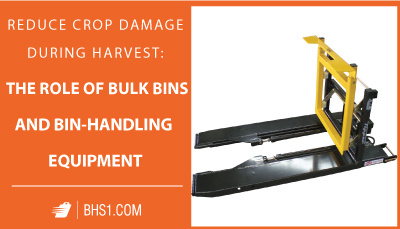We use cookies to make your experience better. To comply with the new e-Privacy directive, we need to ask for your consent to set the cookies. Learn more.
Reduce Crop Damage During Harvest: The Role of Bulk Bins and Bin-Handling Equipment
According to the World Food Programme, we lose a full third of the food we produce to feed the world's populations. This isn't just a problem for hungry communities; it's also a significant source of inefficiency for farmers in every market. 
While produce losses occur at every point in the food supply chain, harvest is a crucial step in which to preserve ripe, ready-to-eat fruits and vegetables for greater saleable yields. The right harvest strategy can eliminate spoilage, breakage, and bruising associated with poor produce handling techniques.
International actors like the United Nations Food and Agriculture Organization (FAO) and Business Social Responsibility (BSR) have extensively studied harvest practices for commercial growers across the world. Here are a few of their recommendations, along with some effective material-handling strategies from the world of industry:
-
Pick directly to harvest bins, or plastic bulk bins with load-limits generally between 500 and 1,500 pounds.
The best way to reduce spoilage in the field is to move the harvest from the field to the packing house as quickly as possible. Reusable plastic bulk bins allow workers to rapidly accumulate large loads of produce. These bins should include fork pockets, so tractors fitted with forks can lift and transport bulk loads out of the sun and into the cooled packing house for grading, packaging, and efficient movement through the supply chain.
-
Choose versatile material handling equipment to reduce transfers of bulk bins on the trip from the field to sorting lines.
While tractors with forks provide efficient means of transport away from the field, switching material handling equipment at the packing house can delay the movement of produce to market — and delays can directly affect spoilage. The ideal material handling device would be able to lift full harvest bins in the fields, carry the load to a packing house, and gently empty bins onto sorting lines in one smooth process.
-
Bin-dumping forklift attachments do the work of several material handling machines, preventing delays at harvest time.
Outfit tractors with Forward Bin Dumper fork attachments, a material-handling solution designed specifically to handle bulk bins like the ones farmers use at harvest. The unit securely attaches to forks, preserving their shape to grasp bins through fork pockets. Steel tabs keep bins firmly in place, even when inverted. At the point of emptying, operators can initiate the tipping action from their seat in the industrial truck. The unit steadily tilts forward 135 degrees to steadily empty produce at packing house.
Preventing harvest-time losses in the field provides wide-ranging benefits to growers, their customers, and, ultimately, society writ large. Commercial farmers improve profits when more of their products reach the market, while increasing the usage existing food lightens farming's environmental footprint while ensuring a ready source of nutrition for hungry populations.
In short, it makes every kind of sense to reduce crop damage, during harvest and throughout the supply chain.
References:
"Harvesting and field handling." FAO. Food and Agriculture Organization of the United Nations, n.d. Web. 18 Aug 2018.
"Losses in the Field: An Opportunity Ripe for Harvesting." BSR. Business Social Responsibility, Apr. 2013. PDF. 18 Aug. 2018.
"Zero Loss for Zero Hunger: WFP's Work to Prevent Post-Harvest food Losses." WFP. World Food Programme, 2018. Web. 18 Aug. 2018.
